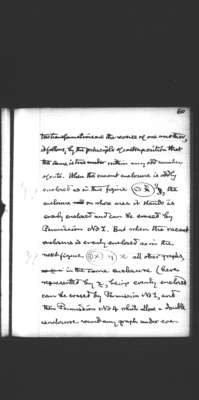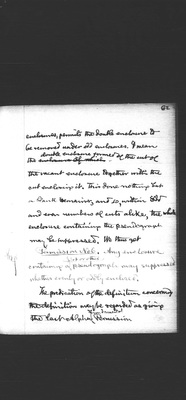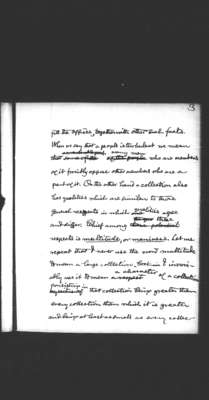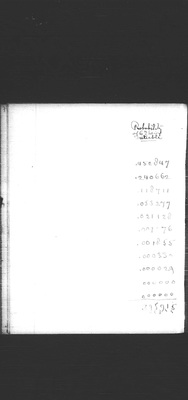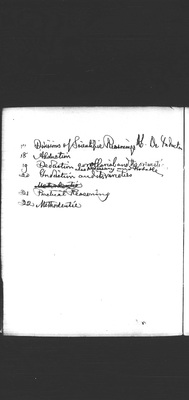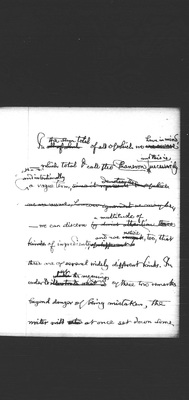Pages That Need Review
MS 455-456 (1903) - Lowell Lecture II
64
60
two transformations are the reverse of one another, it follows, by the principle of contraposition that the same is true within any odd number of cuts. When the vacant enclosure is oddly enclosed as in this figure y, the enclosure on whose area it stands is evenly enclosed and can be erased by Permission No 1. But when the vacant enclosure is evenly enclosed as in the next figure z all other graphs, in the same enclosure (here represented by x[)], being evenly enclosed can be erased by Permission No 1, and then Permission No 4 which allows a double enclosure round any graph under even
65
62
enclosures, permits the double enclosure to be removed under odd enclosures. I mean the double enclosure formed of the cut of the vacant enclosure together with the cut enclosing it. This done nothing but a blank remains; and so, within odd and even numbers of cuts alike, the whole enclosure containing the pseudograph may be suppressed. We thus get
Permission No 6. Any enclosure containing a blot or other pseudograph may [be] suppressed whether evenly or oddly enclosed.
The predication of the definitum concerning the definition may be regarded as giving the last Alpha Fundamental Permission.
68
66
graph, one of which is enclosed by every cut that encloses the other, the former may be erased, this process being termed deiteration.
Rule of Insignificants and the Pseudograph A double cut enclosure can anywhere be inserted and anywhere erased can be circumposed about any graph or be removed from any graph; and the area cont any enclosure containing a vacant cut or other form of pseudograph can be suppressed or inserted.
Now go to p 18
MS 461-463 (1903) - Lowell Lecture III - 2nd Draught
4
3 fill the offices together with other such facts. When we say that a people is turbulent we mean that many men who are members [?] forcibly oppose other members who are a [parbofir?]. On the other hand a collection also has qualities which are similar to those general respects in which qualities agree and differ. Chief among these respects is maltitude, or maniness. Let me repeat that I never use the word multitude to mean a large collection, but I invariably use it to mean a character of a collection consisting in that collection being greater than every collection than which it is greater and being at least as small as every collect-
6
5 existing objects while a quality is a mere general possibility.
The doctrine of multitude dates from the year 1851 when an accurate definition was published of what it means to say that one collection is greater than another, in the posthumous work of the catholic theologian and logician, [Beruhand Bobgano?]. You still search in rain for [Bobgano's?] name in the histories of philosophy, unless in some
MS 473-474 (1903) - Lowell Lecture VII
MS 477-478 (1903) - Lowell Lectures - Syllabus
1
Notes for a Syllabus of Logic
Give 1200 to 1500 words each to the following or about 10 pages [illegible],
1 Divisions of Human Life into Life of [illegible], Life of Anubitum, and Life of Research
2 Division of Science into Idenretic, Catagraphic, or Applied
3 Division of Neurosis into Mathematics, Cenoscopy, or Idioscovy
4 Remarks on Mathematics
5 Division of Cenoscopy into Phoneroscopy, Normology, and Metaphysics
6 Remarks on Phoneroscopy
7 Division of Normology into Esthetics, Ethics, and Logic.
8 Remarks on Esthetics
9 Remarks on Ethics.
10 Its division into Positive and Negative Ethics
11 Division of Logic into Stechoeology, Critic, and Metheore
12 Nature of Signs
13 Divisions of Signs
14 Relations of the Divisions
15 General Principals of Critic
16 Scientific [illegible] and Practical Reasoning
2
17. Divisions of Scientific Reasonings - Af. De Induction 18. Abduction 19. Deduction corollarial and the orematic also necessary and probable. 20. Induction and its varieties 21. Practical Reasoning 22. Methodentic
3
In all of which the sum total of all of which we we are aware have in mind, -- which total I call the Phaneron and this isnecessarily and intentionally a vague term, since it represents the sum of which denot we are moral, however ignorant we may be -- we can discern by denied attention those a multitude of these are of several widely different kinds. In order to illustrate what put the meanings of these two remarks beyond danger of being mistaken, the mister will at at once set down some
MS 292-295 (1906) - Prolegomena to an Apology for Pragmaticism
4
πλ 4 no futher interest. For it is not the particular sample that the chemist is investigating it is the molecular structure. Now he is already in possession of overwhelming evidence that all samples of the same molecular structure react chemically in exactly the same way. The object of the chemist's investigation, that which he experiments upon, that to which his question put to nature relates, in the molecular structure and this has in all samples as complete an identity as it belongs to molecular structure to posses. Accordingly he does as you say experiment upon the very object under investigation. But if you stop a moment to consider it, you will see that you tripped in saying that it is otherwise with experiments made upon diagrams. For what is here the object of investigation? It
